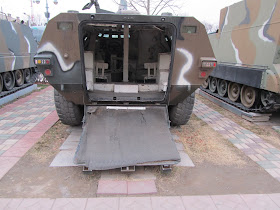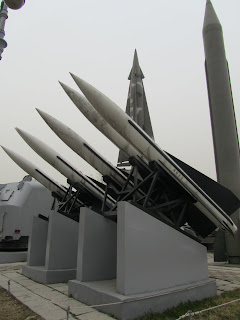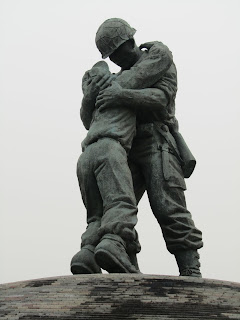Our third museum outing in Seoul was to the War Memorial of Korea in Yongsan-dong. Despite being called a memorial it's really more like a museum and a huge one at that. It first opened in 1994 and it is apparently the biggest landmark of its kind in the world. The museum documents Korean military history with all kinds of artefacts on display ranging from stone arrowheads from prehistoric times to modern guns, tanks, helicopters and planes.
The War Memorial museum of Korea. (Photo from Wikipedia)
It is split into outdoor and indoor exhibits. The indoor exhibits are housed in 7 different exhibition halls: The Memorial hall, The War History Room, The Korean War Room, The Expeditionary Forces Room, The Armed Forces Room, The Large Equipment Room and The Korean Defense Industries Room. These rooms all looked interesting and I've heard that the Korean Wart Room is supposed to be the best part of the museum but we only made it around a couple of them. This was because, despite Lonely Planet reckoning that its possible to see the whole Memorial in 3 hours, we only had 2 hours and I'm one of those annoying people who likes to read every little scrap of information available on each exhibit. We've since visited the memorial again and still haven't seen all of it because it's just so massive so I guess I'll just write about the parts we saw this time and cover the bits we missed in a later blog post.
Painted drum in entrance to museum.
We started with the War History Room that covered Korea's military history from prehistoric times to the start of the Japanese occupation of Korea in 1910. There were the usual stone axes and bronze swords in the prehistoric section. It was fairly well laid out but pretty generic in my opinion. The Three Kingdoms section was more interesting. The Three Kingdoms period ran from 57 AD to 668 AD and refers to the time when Korea as a country didn't really exist yet but was in fact 3 separate kingdoms, the Baekje, Silla and Goguryeo. There were some interesting displays in this section and I particularly liked maps that traced the changing borders of the kingdoms as they fought among themselves and against other local powers for control over the Korean peninsular and parts of China.
The Joseon Dynasty (1392 - 1910) section also had some great artefacts and displays including a hwacha (a kind of early missile launcher that fired lots of arrows at the same time), a mock up of a Hwaseong (Korean castle) and a replica of one of Admiral Yi Sun-shin's turtle ships (Kobukson). There were also some dioramas of Japanese forces invading Korea, something that happened repeatedly in the 16th Century and that would happen again in 1910. According to the museum displays, Korea also frequently had to fight off Japanese pirate attacks throughout its history.
The "Kobukson" or turtle ship was designed by one of Korea's favourite heroes, Admiral Sun-shin, and used by him during the Japanese invasions of Korea in the late 16th century. These ships participated in several important naval victories over the Japanese fleet and have now reached, along with the admiral, a legendary status here in South Korea. However, some boring killjoys say that the importance of these ships may have been exaggerated as there were probably never more than a dozen in service at any one time.
The turtle ships had at least 5 different types of cannon and the dragon head was a cannon too. In fact, the dragon head could also shoot flame from it's mouth - awesome! Most importantly, every ship had a fully covered deck to protect the crew from cannon fire and there were large iron spikes on it to discourage enemy forces from trying to board it. They were hardcore ships!
Mock up of a Korean castle (hwaseong).
Diorama depicting the Japanese invasions of Korea that took place from 1592-1598.
Korean civilians surrendering to invading Japanese forces.
The Hwacha ("fire vehicle") was an early anti-personnel gunpowder weapon that was unique to Korea. It could fire up to 100 steel tipped rockets or 200 flaming arrows in one shot and had a range of up to 500 yards. It was first invented in 1409 and was used extensively during the Japanese invasions of 1592-98. This was a seriously powerful weapon. During the Battle of Haengju, 3400 Koreans managed to hold off 30,000 attacking Japanese soldiers with the help of 40 hwachas. (Photo care of the War Memorial website)
Next, we moved on to the Memorial Hall. This was lined with busts of Korean national heroes who had served various wars including the Vietnam War in which 4700 Koreans were killed. I was surprised to discover that there had been South Koreans there at all, let alone that so many had died in action there. Under each bust, there was a plaque telling the hero's story, usually a rather gory one with plenty of insane acts of bravery. It was pretty awe inspiring stuff and made me glad that I'm a teacher not a soldier.
Busts of Korean national heroes in the Memorial Hall.
This is General Lee Keun-sok, a commander of a fighter wing during the early days of the Korean War. On July 4, 1950, his plane was badly damaged and he couldn't return to base so he destroyed an enemy tank by crashing into it. He received a medal for his brave self sacrifice, posthumously of course.
This was 28 year old Major Kang Chae-ku. He was a company commander who saved several members of his unit by covering, with his body, a live grenade that had been dropped by a soldier during training in preparation for deployment to Vietnam in 1965. Respect to this guy, he really did take his responsibilities to his men seriously. The buck stopped with him.
This is Gunnery Sgt. Jee Deok-Chill. He was a medic dispatched to Vietnam with the 2nd Marine Brigade. On February 1st, he was hit by enemy fire while treating wounded soldiers. Although he was wounded, he managed to kill 20 enemy soldiers before being killed himself . Another posthumous medal.
Once we'd had our fill of national heroes and tales of insane bravery, we moved back towards the entrance where we found a temporary exhibition about the Cheonan. The Cheonan was a South Korean naval ship that broke in half and sank near the sea border with North Korea on 26th March 2010 with the loss of all 46 members of its crew. An international investigation team concluded that the Cheonan was sunk by a torpedo launched by a miniature North Korean submarine. Of course, this caused a lot of bad feeling between the two Koreas and made everybody very twitchy for a while as North Korea apparently has some nuclear capability.
The Cheonan exhibition used photos of the ship, its crew and the wreckage that was salvaged in the following weeks to document what happened.
Seeing photos of the "46 warriors of the Cheonan" was moving. Some of the crew looked very young and reminded me of my middle school students. South Korea still has conscription for boys so we know that most of our male students will spend a couple of years in one of the branches of the armed forces. It's depressing to think that they could end up like this.
I remember all this was kicking off just before I came to Korea and I did wonder what on earth I was letting myself in for but I have never really felt like I live in a divided country that is technically still at war (the North and the South never actually signed a peace treaty at the end of the Korean war). Sure, there have been a few national drills to practice for the potential invasion from the North but no one takes those seriously. The shelling of Yeonpeong island by North Korea in November 2010 was more serious and 2 South Korean soldiers and 2 civilians were killed. The image of smoke billowing out of shattered houses clearly shook people up here as this was the first attack on South Korean soil in decades. Even my co teachers were worried. Still everything seems quiet now so we'll see.
Next, we moved outside. The outdoor exhibition area was huge and really interesting. It had loads of cool outdoor displays of military vehicles form the Korean War and from other wars too from a range of different countries. There were aeroplanes, helicopters, missiles, armoured personnel carriers (APC), tanks, trucks and boats. Even better, you could actually go inside or clamber on board most of the vehicles which was fascinating in that it gave you an idea of just how cramped and uncomfortable some of those tanks and APCs were. Of course, being able to get inside the vehicles was a big hit with the kids too as well as their gung ho dads. I think this is another example of a Korean museum focussing on making its exhibits an interactive experience just as many parts of Seodaemun Prison museum were interactive. I couldn't imagine a similar museum in London (such as the Imperial War Museum) allowing visitors to climb all over the military hardware but I certainly enjoyed the experience!
Some kind of big tank - sorry my knowledge of military vehicles aint all that!
That big tank again - from the front this time.
Plane!
The massive B-52 Bomber. It was so huge I couldn't fit it all in one photo!
Big metal ship ahoy!
This strange looking covered speedboat is actually a North Korean semi submarine. It was used by the North when they infiltrated South Korea by sea near Busan on 3 December 1983.
Yay! More tanks and you could climb on these ones.
Driver's seat inside a tank. Not very comfortable.
The very cramped metal innards of an armored personnel carrier. I think this thing had a crew of 8 or 10 people that crowded together in there.
A U.S. Cobra helicopter. It was developed in 1967 and used by the Americans during the Vietnam War. Korea started using these helicopters in 1976.
Rocket!
A phallic rocket composition. Scary but faintly ridiculous at the same time.
Military speedboat thingy.
The outdoor area also contained The Korean War Monument, the massive Statue of Brothers and the Peace clock tower. And, on the left side of the museum entrance there is a monument containing all the names of the UN soldiers who were killed in the Korean War.
This is the huge Statue of Brothers. It is a symbol of the Korean war and depicts two Korean brothers who are both soldiers. The older on is a South Korean soldier and the younger one is from the North Korean army. They are meeting in a battlefield and expressing love, forgiveness and reconciliation according to the information next to the statue. The crack down the dome represents the division between the North and the South but also the hope for reunification.
Close up of the two brothers. Wonder why the South got to be the big brother - maybe that's how they feel they stand in the relationship.
The Statue of Brothers against the backdrop of a hazy early Spring afternoon with the usual apartment blocks rising up in the background.
Monument depicting South Korean soldiers during the Korean War.
Close up of part of the monument.
Korean soldiers helping a wounded colleague.
The War Memorial is a great museum and if you ever happen to be in Seoul with a few spare hours on your hands I'd definitely recommend a visit. We saw a lot of interesting stuff but we missed a lot more. We didn't get to the Korean War room which is supposed to be really fascinating. We also missed out on a mock up of some Viet Cog tunnels which would have been cool. On the weird, interactive display front, we missed the Combat Experience room and the shooting range which both sound intriguing. But they'll have to wait for another day and another post - watch this space!
































No comments:
Post a Comment